Are you ready to grow your own cherry trees? This guide will teach you how to care for these amazing trees in your garden. Imagine having trees that give you delicious fruit and beautiful spring flowers. Let’s start this journey together.
Cherry trees are loved in American gardens. They come in many types, from the famous ones given by Japan to the tasty ones for cooking. With the right care, you can have these beautiful trees in your yard too.
Botanical Classification and Growing Conditions
Cherry trees are part of the Prunus genus. This group includes many species found worldwide. The main types for their fruits are Prunus avium (sweet cherries) and Prunus cerasus (sour or tart cherries).
Botanical Names
The names for cherry trees are Prunus avium for sweet cherries and Prunus cerasus for sour cherries. These names help us tell the different types apart.
Height and Spread
Cherry tree sizes vary by species and type. Standard sweet cherries can reach 35 to 40 feet tall and wide. Dwarf types are much smaller, 5 to 10 feet tall and wide.
Tart cherry trees are also smaller. Standard ones are 20 to 25 feet tall and wide. Dwarf types are 8 to 10 feet tall and wide.
Sun Exposure Requirements
Cherry trees need full sun to produce fruit well. They do best in places with long, warm summers and mild winters.
Soil Requirements
Cherry trees like soil that drains well and has a pH of 6.0 to 7.0. The soil should also be low in alkalinity and salinity for healthy growth.
Hardiness Zones
Sweet cherry trees do well in zones 5 to 7. Sour cherry trees can grow in zones 4 to 6. Hardiness zones show the temperature range a cherry tree can handle.
| Cherry Tree Type | Hardiness Zones | Height and Spread | Sun Exposure | Soil pH |
|---|---|---|---|---|
| Sweet Cherry (Prunus avium) | 5 to 7 | 35-40 ft (10-12 m) tall and wide (standard), 5-10 ft (1.5-3 m) (dwarf) | Full sun (at least 6 hours per day) | 6.0 to 7.0 |
| Sour/Tart Cherry (Prunus cerasus) | 4 to 6 | 20-25 ft (6-7.5 m) tall and wide (standard), 8-10 ft (2.4-3 m) (dwarf) | Full sun (at least 6 hours per day) | 6.0 to 7.0 |
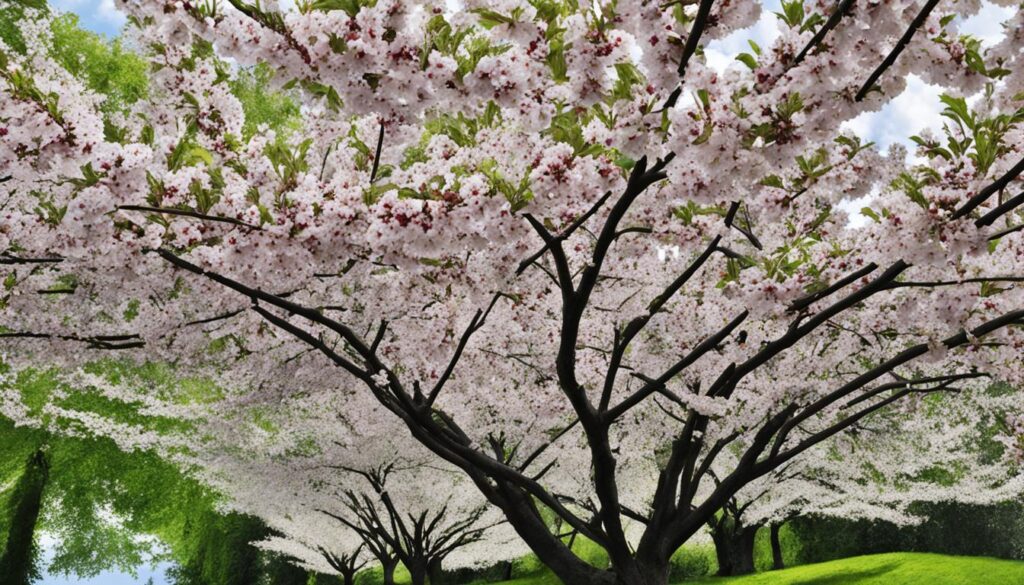
Planting Cherry Trees
Planting cherry trees at the right time is key. Early spring or late fall is best when the ground is soft and moist. This helps the roots grow strong before the hot summer or cold winter hits.
Cherry trees love sunny spots with good air flow. They don’t do well in deep shade, especially under big trees or buildings.
Site Selection
Finding the perfect spot is vital for your cherry trees. They need at least 6-8 hours of sunlight a day. The soil should drain well and have a pH of 6.3 to 7.2 for sweet cherries, or 6.0 to 7.0 for sour cherries.
Avoid planting near heavy footpaths or under big trees that might steal their food and water.
Planting Bare Root vs. Potted Trees
You can plant cherry trees either bare root or potted. Bare root trees are tougher and cheaper but need to be planted in early spring or late fall. Potted trees can be planted any time but need more care to grow their roots.
Make sure the graft union is at the right height, below or above the soil, depending on the rootstock. This helps the tree grow strong roots. Add 2-3 inches of organic mulch around the tree to keep weeds away and keep the soil moist.
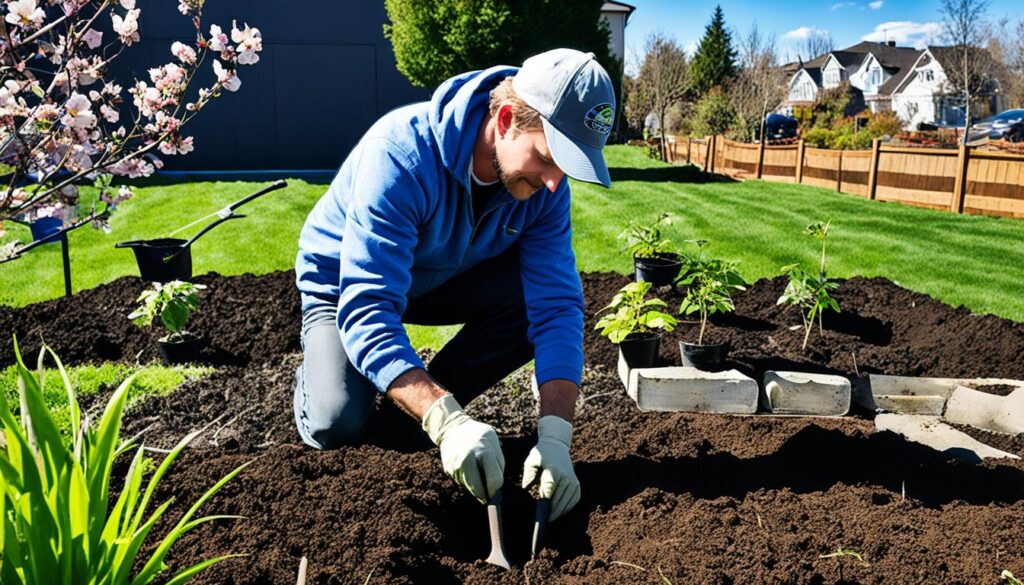
With the right planting and site choices, your cherry trees will flourish. They’ll give you lots of fruit for many years.
Caring for Cherry Trees
Watering Needs
Watering your cherry trees right is key to their health and fruiting. In the growing season and summer, they need at least 1 inch of water each week. For new trees, water them deeply and slowly every 1 to 2 weeks.
Older trees might not need more water if it rains enough.
Fertilizing Guidelines
For fertilizing cherry trees, use a little compost or a 16-16-16 organic fruit tree mix in early spring before they bloom. Don’t overdo it with the fertilizer. Too much can make them grow too much and not produce fruit.
Regular watering and balanced fertilizing will help your cherry trees grow well and give you lots of fruit. Just follow these easy steps to feed your trees right.
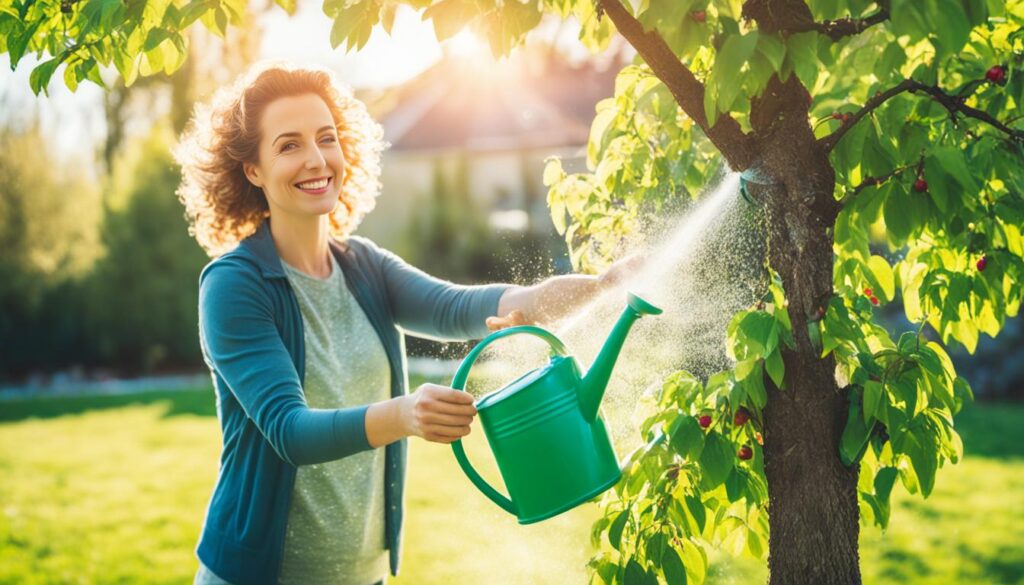
| Watering Needs | Fertilizing Guidelines |
|---|---|
|
|
Pruning Cherry Trees
Cherry trees need pruning every year, best done in late winter when they’re dormant. This helps open up the tree, remove old branches, and grow new ones that bear fruit. Make cuts just above an outward-facing bud to keep the tree looking good.
Using the right pruning techniques is key for cherry trees. It keeps the tree’s shape, lets air move through, and boosts fruit production. Prune fruit trees in winter, but wait until late summer for sweet cherries to keep them strong.
- Start pruning young cherry trees in early spring. Shape them and train them before they bloom. Cut the leader at a 45-degree angle, leaving it 24 to 36 inches tall. Create scaffold whorls for lateral branch growth.
- When the tree is three years old, prune out new vertical limbs. This encourages outward growth and removes dead, diseased, or crossed branches.
- Prune sweet cherry trees to a «Central Leader» structure. Pie/sour/tart cherry trees work well with an «Open Center» or «Vase-Shaped» structure for better light and air.
- Thin fruit on cherry trees to prevent branch breakage. It also makes the fruit bigger and better, and stops the tree from bearing fruit unevenly.
Proper pruning is vital for cherry trees. It keeps them healthy, shaped right, and productive. By following these tips, your cherry trees will flourish and give you lots of fruit for many years.
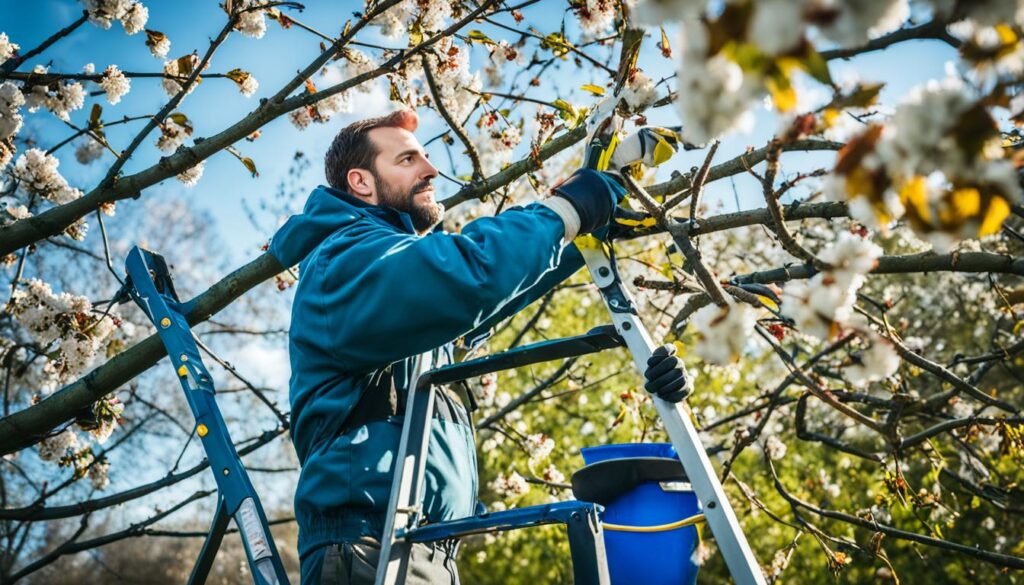
Cherry Trees Pollination
For growing cherry trees, pollination is key. Sweet and sour cherry trees need different pollination. Knowing their needs helps get a good harvest.
Sweet Cherry Pollination
Sweet cherry trees need another tree to pollinate. Plant two or more sweet cherry types close to each other. This lets honeybees move pollen well, helping trees produce fruit. Stella and Compact Stella are special, they can pollinate themselves.
Sour Cherry Pollination
Sour cherry trees can pollinate themselves. But, having another tree nearby helps produce more fruit.
Don’t use pesticides when cherry trees are blooming. These can hurt honeybees, which are key for pollination. Also, having flowers other than cherries nearby helps wild bees. This makes pollination better for your trees.
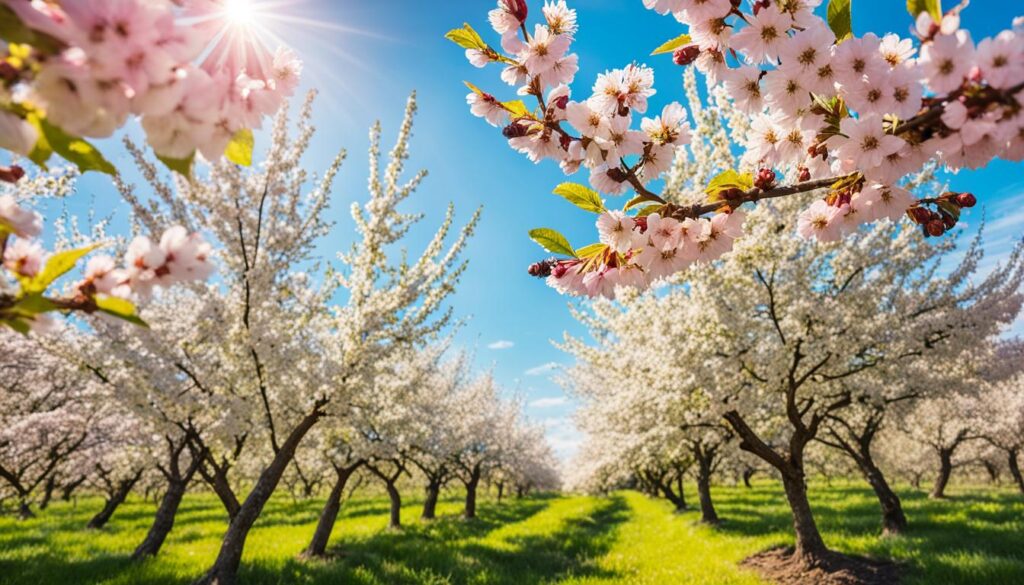
Knowing how sweet and sour cherry trees pollinate helps gardeners. Planning for pollination is key to growing successful cherry trees.
Harvesting Cherry Fruits
Harvesting cherries is all about timing. They ripen from May through July, depending on where you are and the type of cherry. Look for cherries that are dark and slightly soft when you press them. Remember, cherries don’t get riper after picking, so wait until they’re fully ripe.
When to Harvest
The best time to pick cherries is usually from mid-May to mid-June. Sweet cherries are ready when they’re plump and juicy, about 1 inch wide. The stems come off easily. Sour cherries are ripe when they pull off the stem easily too.
Harvesting Techniques
- Use scissors or pruners to cut the fruit with the stem attached, being careful not to damage the spur (fruiting twig) on the tree.
- Avoid pulling the cherries off the tree, as this can damage the tree and reduce future yields.
- Handle the cherries gently to prevent bruising or damage, as they are delicate and can spoil quickly.
- Store the harvested cherries in the shade and refrigerate them promptly to maintain freshness.
Follow these tips for harvesting cherries to get a great harvest. This way, you’ll have plenty of delicious cherries from your trees.
Cherry Trees Varieties
There are many types of cherry trees, each with its own special traits. They are mainly split into three groups: sweet cherries, sour cherries, and flowering cherries.
Sweet Cherry Varieties
The ‘Bing’ cherry is a top pick for its deep red, juicy cherries. The ‘Rainier’ cherry is loved for its golden-yellow color with a crimson blush. The ‘Stella’ cherry tree is also popular but is not good in cold weather.
Sour Cherry Varieties
The ‘Montmorency’ cherry is a big hit for making pies and toppings, making up 96% of the market. Other great sour cherries are the ‘Meteor’ and ‘Ulster’, with the ‘Ulster’ being less prone to rain damage.
Flowering Cherry Trees
If you want cherry trees for their beautiful spring flowers, try the ‘Yoshino’ or ‘Kwanzan’. These trees are known for their lovely pink flowers. They look great but don’t produce as much fruit.
Whether you like the sweet ‘Bing’ cherries or the pretty ‘Yoshino’ flowers, there’s a cherry tree for you. Knowing the special features of each type helps you pick the best one for your garden. This way, you get a tree that looks great and gives you lots of fruit or flowers.
Common Problems with Cherry Trees
Cherry trees are usually tough but can face pests, diseases, and environmental issues. These problems can affect their growth and how much fruit they produce. Knowing about these issues helps gardeners keep their cherry trees healthy.
Pests and Diseases
Common pests include fruit flies, apple maggots, peach tree borers, and caterpillars. These pests can harm the fruit and leaves, making the tree unhealthy. Cherry tree diseases like brown rot, cherry leaf spot, and powdery mildew are also big problems. They can cause fruit to spoil, leaves to turn color, and leaves to fall early.
Black knot is a big disease for Prunus trees, including cherries. It’s a fungal infection that makes branches swell into hard, black bumps up to 6 inches long. This can reduce how much cherries the tree makes.
Environmental Issues
Cherry trees face environmental challenges too, like extreme weather. Too much heat can cause sunburn on the branches. Heavy rain can lead to too much fruit or «spur» fruit. Birds can also damage sweet cherry trees, needing netting or other ways to keep them away.
Planting, caring for, and managing pests and diseases are key to solving these issues. Regular pruning, watering, and pest control help keep cherry trees healthy and productive for a long time.
Cherry Trees for Marin County
If you’re a gardener in Marin County, growing cherry trees can be a bit tricky. The area’s high temperatures, foggy conditions, and heavy soils can challenge these fruit trees. But, with the right approach, you can enjoy a bountiful cherry harvest.
When picking cherry varieties for Marin County, look for ones that fit the local climate well. Bing, Rainier, and Montmorency are great choices. Bing cherries are big, dark red, and taste great. Rainier cherries have a unique yellow to pinkish color. The Montmorency variety is a sour cherry that grows a lot and doesn’t need another tree to produce fruit.
To get the best results with growing cherry trees in Marin County, remember these tips:
- Choose a spot that gets full sun.
- Water the trees regularly to keep the soil moist.
- Use netting or other methods to protect against birds.
- Ask your local nursery if your cherry tree needs another tree to produce fruit.
With the right care and the right cherry variety, you can enjoy the fresh, seasonal taste of growing cherry trees in Marin County.
Containing the Keyword: cherry trees
This guide has focused on the versatile and loved cherry trees. It covered their origins, the many types, and how to plant, care for, and harvest them.
The keyword «cherry trees» and related terms like «flowering cherries» and «dwarf cherry trees» were used often. This makes the article easy to find online and helps gardeners find useful info.
The article shared about cherry trees’ history, how they grow, and common problems they face. It gives readers the info they need to grow these beautiful trees in their gardens. Whether you like their spring flowers or the fruit they produce, this guide has lots of useful info.



